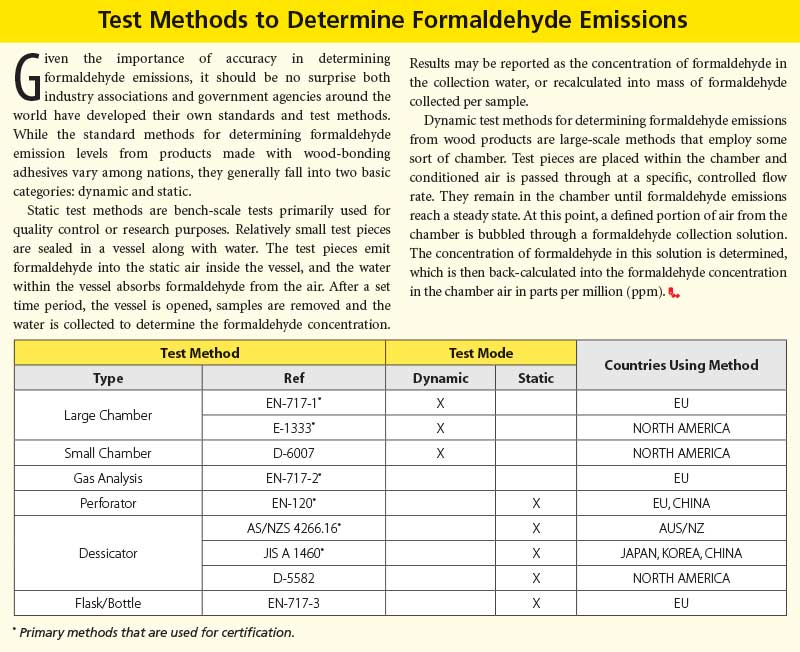Understanding formaldehyde emissions and health
 Range of adhesive options
Range of adhesive options
The growing concerns over formaldehyde as a carcinogen and the accelerating trend to tighter standards around the globe have had an impact on adhesive manufacturers. Some have developed new adhesives that do not emit formaldehyde. Others have found ways to reduce the level of formaldehyde emissions from their products, although the fundamental chemistry has not changed.
The result is the evolution of a range of adhesive system options, as well as the arcane terminology used by adhesive manufacturers to describe these systems.
No-added-formaldehyde adhesives
Among the latest developments are efficient and effective adhesives that do not add any formaldehyde into the environment. These are classified as no-added-formaldehyde (NAF) products. Specifying an NAF adhesive ensures the lowest level of formaldehyde content for any type of wood product.
Soy-based adhesives, which neither contain nor emit formaldehyde, are the latest breakthrough in NAF adhesives. Made from soybeans (a renewable resource) and a proprietary cross-linking resin, these materials could be a game-changer.
They contain low levels of volatile organic compounds (VOCs) and are safer to handle than isocyanate-based adhesives (described later in this article), which also do not contain formaldehyde. This makes soy-based adhesives increasingly attractive to producers of manufactured wood products concerned with formaldehyde-related health issues and safety in their production facilities.
The advantages of soy-based adhesives are not limited to workplace health and safety. They meet or exceed all critical performance targets and can be substituted with relative ease for widely-used urea formaldehyde-based adhesives in manufacturing processes.
As a result, over the past five years, soy-based adhesives have gained significant share in markets such as decorative hardwood plywood and engineered wood flooring, where they have more than 50 per cent market share. They are also becoming increasingly popular in particleboard, MDF, and OSB.
Another NAF option available to manufacturers looking for alternatives to formaldehyde-emitting adhesives are products made with isocyanates. Their benefits are their strength and high resistance to water. These adhesives are widely used to produce OSB and their use in MDF and other composites is growing. However, isocyanates have limited use in engineered wood flooring and plywood due to their processing requirements.
Further, strict attention to safety protocols is extremely important when product manufacturers apply isocyanates using spraying or atomization given the significant concerns of government health and safety agencies and others about the toxicity of vapourized isocyanate.
Polyvinyl acetate (PVAc) adhesives are commonly used by fabricators assembling furniture or small components and occasionally employed by manufacturers of plywood and engineered wood flooring. They are easy to pump and handle, but require very fast manufacturing times that not all companies can accommodate. Some PVAc adhesives contain small amounts of formaldehyde (or formaldehyde-generating components), so manufacturers must be careful about selecting them and then claiming they are ‘formaldehyde free.’
NAF adhesives meet all standards and requirements for no added-urea formaldehyde (NAUF) products. Importantly, wood products made with any NAF adhesive will qualify for points under the Canada Green Building Council’s (CaGBC’s) Leadership in Energy and Environmental Design (LEED) rating program (i.e. Indoor Environment Quality [EQ] Credit 4.4, Low-emitting Materials: Composite Wood and Agrifibre Products). Further, each of the NAF adhesives comply with all the global formaldehyde regulations for wood products.
Urea-formaldehyde adhesives
At the opposite end of the spectrum are urea-formaldehyde (UF) adhesives. UF adhesives emit formaldehyde into indoor environments at the highest rates. As a result, they have and will continue to receive close scrutiny from regulators around the world.
UF adhesives are the most widely used adhesive systems because they offer a number of advantages to the manufacturers of wood products, including:
- low cost;
- ease of use under various conditions;
- low cure temperatures;
- hardness;
- excellent thermal properties; and
- lack of colour (especially of the cured resin).







